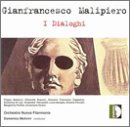| All Artists: Giovanni Francesco Cappelluti, Gian Francesco Malipiero, Domenico Molinini, Petruzzelli Ensemble, Orchestra Nuova Filarmonía, Domenico Di Leo, Antonio Piccialli, Filippo Balducci, Annamaria Strano, Lucia Naviglio Title: Gianfrancesco Malipiero: I Dialoghi Members Wishing: 0 Total Copies: 0 Label: Stradivarius Original Release Date: 1/1/2003 Re-Release Date: 1/7/2003 Genres: Pop, Classical Styles: Vocal Pop, Chamber Music, Forms & Genres, Concertos, Historical Periods, Modern, 20th, & 21st Century, Instruments, Strings, Symphonies Number of Discs: 2 SwapaCD Credits: 2 UPCs: 723724513921, 8011570336200 |
Search - Giovanni Francesco Cappelluti, Gian Francesco Malipiero, Domenico Molinini :: Gianfrancesco Malipiero: I Dialoghi
 | Giovanni Francesco Cappelluti, Gian Francesco Malipiero, Domenico Molinini Gianfrancesco Malipiero: I Dialoghi Genres: Pop, Classical
|
Larger Image |
CD DetailsSimilar CDs
|
CD ReviewsNot always the best Malipiero, and flawed live recordings Discophage | France | 02/16/2008 (3 out of 5 stars) "I have greatly enjoyed recently the Symphonies of Malipiero, published in the mid-1990s by Marco Polo, which I found to be often compositions of striking originality (see my reviews of Gian Francesco Malipiero: Symphonies Nos. 3 & 4; Sinfonia del mare, Gian Francesco Malipiero: Symphonies Nos. 5, 6, 8 & 11, Malipiero: Symphony No.7/Sinfonia in un tempo/Sinfonia per Antigenida and Malipiero: Symphonies No. 9 dell'ahime, No. 10 Atropo, Sinfonia dello Zodiaco), so I decided to investigate the present 2-CD set. The Dialoghi were composed between 1955 and 1957 and involve various instrumental groupings, from two pianos (Dialogo 2) and voice and two piano (Dialogo 3) to Concerto for Two Pianos (Dialogo 7) and Chamber Orchestra (Dialogo 1). The order of numbering does not exactly replicate the order of composition, which apparently followed a rising order of instrumental forces, from two pianos to large orchestra. The Dialogues are not all of concertante nature (only 5, 6 and 7 are real concertos, e.g. pitting a soloist against an orchestra, respectively the viola, harpsichord and two pianos) but as their title implies they all involve some kind of dialogue, either between instruments or between voice and instruments - sometimes it is even, apparently, a dialogue between Malipiero and others: fellow composer Manuel de Falla (Dialogo 1) or the Medieval Italian poet Iacopone da Todi (Dialogo 3).
According to the liner notes, although some individual Dialogues have been recorded before, this is the first recording of the complete cycle. In fact these are live recordings, made on the occasion of a Malipiero festival in October 1999. Sonic quality is variable (the sonic relation between the two pianos in Dialogo 3 seems very artificial, as if it were a re-recording, and I don't think the composer intended the two instruments to be tuned micro-tonally, but that is how they sound here; the two-pianos in the Dialogo 7 for two pianos & orchestra sound more distant than the orchestra, and at 2:27 there is a short patch where the strings seem to be playing outside the hall), there are coughs and various extraneous noises (soloists breathing, score pages turning, even a child shouting at 8:18 into the 8th Dialogue, the Death of Socrates - a burst of emotion, no doubt), and the strings would have done well with a lot more rehearsals, just to learn to play on the same pitch together. Despite the Dialoghi's date of composition, I find that some of them smack very much of the Twenties. The 1st Dialogue, for small orchestra, is dedicated to the memory of Manuel de Falla and pieces like El Retablo de Maese Pedro or the Harpsichord Concerto can come to mind. The mood is mostly brooding, with flights into a more neo-classical rhythmic vigor, and the textures are sparse, chamber-like, often dominated by the high-pitched woodwinds (piccolo, oboe), with the presence of the piano playing as basso instrument, giving it all the aspect of a Concerto Grosso. Yet, although it is Dialogo 1 for small orchestra that bears a dedication to Falla, if you want to hear a remake of Falla's Cembalo Concerto, try Malipiero's 6th Dialogue, itself a Harpsichord Concerto. And if you want to hear a remake of Satie's "La Mort de Socrates", try Dialogue 8 - which bears the same title, but in Italian. It has the same kind of sternness, greyness, bland recitative-like vocal writing. Baritone Cappelluti doesn't command a great variety of colors either, and sounds strained in some of the climaxes. But there are a few touches of orchestral color here and there that are very much Malipiero's own. The same speech-like blandness pervades Dialogo 3 for Soprano and two Pianos on poems by da Todi, and Lucia Naviglio sings with an unflattering voice. Dialogo 4 is a Wind Quintet (flute, oboe, clarinet, horn & bassoon) and it has the perky sauciness one associates with, say, similar works of Janacek - but, it must be said, without Janacek's unique personality. There is something in the Dialogo 7 for 2 pianos & Orchestra which reminds me of the music that George Antheil, the self-styled "Bad Boy of Music", wrote in the twenties - a willingness to pound, the dogged ostinatos, the boisterousness of the finale. But the backward placement of the two pianos and strings' approximate intonation does hamper some of the enjoyment. There is also something very Stravinskian in the way Dialogo 2 for two pianos begin - snappily pounding chords, off-beat rhythms, it is the universe of the Concerto for Two Solo Pianos. On the other hand, the chromatic writing of the second movement is vaguely evocative of Scriabin or of the American "mystics" such as Dane Rudhyar - add to that the placement and tuning problems mentioned above, and you could also be in Ivan Wyshnegradsky's quarter-tone music. Dialogo 5 is a Viola Concerto, reminiscent maybe of Hindemith's Kammermusik 5 due to the chamber-like character of the orchestra, but without the German composer's lively motorism. It is brooding, austere, lyrical. One of its nicest features is, indeed, its concertante nature, its constant chamber-like dialogue between viola and other solo instruments. But it lacks the touch of individuality that makes the greatest pieces in the form stand out - Bartok's Viola Concerto, Hindemith Kammermusiken for instance. Violist Simonide Braconi plays with fine tone. The liner notes are very Italian - long on general considerations and fluffy twaddle, short of facts: you've really got to read carefully if you want to know the dates of composition, and nothing is said about circumstances. Each work gets only one cue point - meaning that the inside movements are not cued. TT is an acceptable 1 hour 52. In the end, this is for the serious Malipiero listener only. Others should be advised to try the Symphonies or the String Quartets first. " |

 Track Listings (4) - Disc #1
Track Listings (4) - Disc #1
